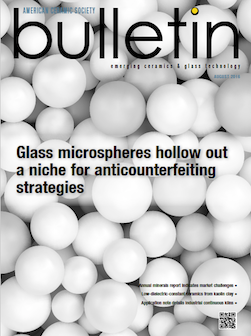
The August issue of the ACerS Bulletin is now available online.
This month’s cover story delves into dark territory: the world of counterfeiting. Did you know that counterfeit goods—whether watches, computer chips, money, pharmaceuticals, or much more—make up an incredibly lucrative market? Recent estimates put the global counterfeit goods market in the range of $1.7 trillion. Perhaps even more surprising is that novel anti-counterfeiting solutions are turning to ceramic and glass materials to help sort genuine from fake goods. Authors George Wicks, Grant Crawford, Jon Keller, Fred Humes, and Forest Thompson highlight their work to develop security inks that incorporate porous-wall, hollow glass microspheres for a new take on anti-counterfeiting solutions. The microcapsules can be loaded with functional security materials that can respond to outside stimuli on demand—read on to see the rich potential of these unique glass microspheres.
The August issue also features the annual minerals report, mined from data in the United States Geological Survey’s Minerals Commodity Summary 2016. The full summary details 2015 statistics on the production, supply, and overall market for more than 90 minerals and raw materials. It all starts with raw materials, so we pulled out some salient statistics and trends for a handful of mineral commodities that are of particular interest in the ceramic and glass industries. You’ll find those details in an easy-to-read table that lets you glimpse individual materials’ markets at a glance.
Another August feature article by Baohua Yu, Xiuxiu Yuan, Yingjie Liu, Ping Lu, Bin Li, Huaiqi Li, Yuehua Zhang, and Yanqiu Jing details the researchers’ efforts to develop low-dielectric-constant ceramics from kaolin clay. Although kaolin clay has great potential as such a material, the porous surface of sintered kaolin has posed significant barriers in past attempts to use the material. The authors instead explored sintering and sol–gel infiltration techniques to help synthesize dense kaolin ceramics for potential fabrication of electronic devices.
This new issue also includes a short kiln application note detailing how to select the proper kiln application for high-temperature process engineering of advanced ceramics. Written by Hartmut Weber of Riedhammer GmbH in Germany, the article details two interesting examples that show how continuous furnace systems can meet the needs of technical ceramics manufacturers.
Plus, there’s lots more good stuff inside this—and every issue—of the ACerS Bulletin. The current issue is free to all for a short time, but remember that all the valuable content in over ninety years of past issues of the ACerS Bulletin is free only to members—so considering joining us today!

